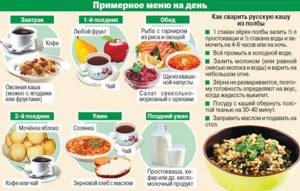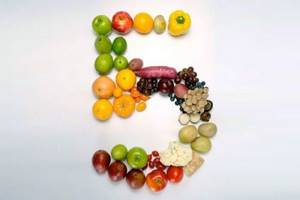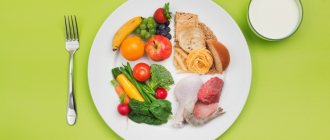Of course, for many people, being overweight is a sore subject. And no matter how you try to reset it, you cannot achieve the desired result 100%.
And various “fashionable” ultra-modern methods of losing weight do not always help, and in the worst case, they aggravate the situation with obesity. Because it is important to know that in the use of such methods, you can greatly “damage” your body, which will lead either to even greater obesity or to acquired diseases. No matter what a person invents in this direction, only proven ones still work, old effective methods - fractional meals.
Having seen enough on social networks of cool fitness nutritionists who lose weight in a dubious way, showing the public the part of the basis that practically without consuming food, but only suppressing their hunger with a “piece of cheese”, they have a gorgeous body.
To be slim, you must first of all be healthy - and eat better on time!
Operating principle
The diet is divided into several stages. The first stage involves a strong reboot of the body - for five days you must strictly follow a certain diet. Next comes the consolidation stage. The regime is not as strict, and you are allowed to eat some “non-diet foods”. During this period, you consolidate the previously obtained result, and your body is completely rebuilt (scientists have proven that this time is enough to get used to the new regime). As you can see, your main difficulty is to endure these ill-fated five days, and then you will feel relief and a surge of strength.
The results promise stunning: in the first stage, up to 3 kg are lost, then we strengthen the result. Then we repeat the five-day period again and consolidate the result! Example: if you have 10 extra pounds, the course can be repeated three times.
What is the difference from other diets? Firstly, you will not encounter the so-called “yo-yo effect” (girls who are always losing weight know what they are talking about). This is when everything previously lost comes back with extra weight, and you have to go through all the circles of weight loss hell again.
This happens due to the fact that after finishing the diet we “have a blast” and pounce on unhealthy high-calorie foods. A smooth transition to prohibited foods will give your body time to adapt and your hunger to subside.
Another trick is the roller coaster principle. The fact is that our body is quite cunning, and if we torture it with diets and hunger strikes for a very long time, sooner or later it will begin to store fat in reserve and the weight loss process will slow down significantly. Constant changes in eating habits will throw surprises at us, thanks to which our metabolism will speed up every day.
An undeniable advantage will be the versatility of the diet - thanks to its high protein and vegetable content, it is suitable for both women and men.
Eligible Products
How to eat and what to eat during a fractional diet depends on your individual characteristics and taste preferences. Proper nutrition should include: proteins, fats, plant fibers, vitamins and minerals.
The menu includes:
- seafood;
- lean meats;
- fermented milk products: cottage cheese, kefir, fermented baked milk, yogurt;
- cereals, everything except wheat and semolina;
- nuts and seeds;
- vegetables and fruits.
The use of vegetable oil is allowed, but not more than a tablespoon per day. Salt is strictly in limited quantities.
Fish and seafood
Seafood and low-fat varieties of sea fish contain Omega 3 acids, vitamins, iodine and fluorine, which are necessary for the normal nutrition of body tissues. With a lack of fatty acids, a person’s skin loses elasticity, hair becomes dull, and nails become brittle. Lack of iodine affects the functioning of the endocrine system. Fluorine prevents various bone pathologies, as it takes part in the mineralization of bone tissue and teeth.
Fish in fractional meals can be consumed in any main meal, as it is a protein that breaks down fats and is highly digestible.
Fish goes well with grains and vegetables. Steam, grill or bake in the oven. Recommended dosage is 200–300 g per week.
Lean meats
Lean meats include:
- turkey;
- veal;
- horsemeat;
- chicken breast.
It is a mistake to think that skinless chicken becomes a dietary dish. The hidden fats found in any meat are dangerous.
Lean meats provide protein, which is necessary for the formation of muscle tissue. Vitamin B 12 and iron in the composition prevent the development of anemia and help strengthen the immune system.
A healthy diet allows for the consumption of 150–200 g of lean meat per day. In detailed nutrition, it is appropriate to eat meat for lunch.
Dairy products
Fermented milk products include natural yogurt, kefir, fermented baked milk, cottage cheese, yogurt, and sour cream. They are an integral part of the fractional diet and are included in the daily diet.
Beneficial bifidobacteria and lactobacilli in fresh yogurt and kefir help improve stomach function and restore natural peristalsis. Calcium in dairy products is necessary for the body for the formation of bone and cartilage tissue, hair and nail growth.
Use at any meal and during snacks. At night after 18-00 it is allowed to drink a glass of kefir.
Cereals
Cereals contain plant fibers and take a long time to be absorbed by the body. The most valuable dietary foods are buckwheat, oatmeal and rice. Buckwheat porridge is rich in iron, vitamins and is absorbed by the body for a long time. Rice removes excess water from the body, envelops the walls of the gastrointestinal tract and protects the mucous membrane from the harmful effects of gastric juice.
Used in any of the main meals, goes well with meat, seafood, and vegetables. But we must not forget that fractional meals are not a mono-diet. It is permissible to eat no more than a glass of cereal per day.
Vegetables and fruits
It is impossible to lose weight without eating vegetables and fruits every day. Steamed, baked or stewed vegetables should account for 65% of your daily diet. Vegetables contain plant fibers and fiber, which help remove toxins and improve metabolic processes.
Not all fruits are suitable for weight loss.
Allowed:
- apples;
- pears;
- citrus;
- avocado;
- kiwi.
How to organize meals 5 times a day?

Today it is difficult to find a person who would eat a full breakfast, much less stick to 5 meals a day. And all because we are always in a hurry somewhere, snacking on the go, and so it turns out that we gain weight and worsen the quality of our health.
How can everything change? First of all, you need to set yourself a strong motivation, create the right conditions for eating food under fractional nutrition conditions.
Attention: purchase a set of dishes in advance that will be small in size, but attractive enough so as not to be irritated at the adaptation stage.
There are many advantages of eating 5 meals a day, which you should clearly outline to yourself:
- there is no feeling of hunger, and therefore there is no need to snack on the run, eating unhealthy and high-calorie foods;
- there are no strict restrictions on the range of products, the weight loss process is smooth and healthy;
- nutrients, vitamins and microelements that enter the body in moderate quantities are better absorbed;
- It’s psychologically easier to lose weight when you know that in a few hours you’ll be eating again;
- after a heavy meal you always feel sleepy and there is no strength to maintain high performance, in this case the opposite is true - light food allows you to keep the body in good shape;
- calories are consumed faster and converted into energy rather than remaining as fat deposits;
- sleep becomes calm and complete - the key to excellent prevention of excess weight.
There is nothing to be proud of when people say that they eat once or twice a day, in which case muscle mass is destroyed, the fat layer increases, insulin levels change for the worse, and their health becomes worse.
What is a diet by the clock
This is a reliable method to lose weight quickly and noticeably. The result is not noticeable immediately, but after a month the number of problem areas of the figure will be reduced significantly. Meals by the hour for weight loss include up to 8 daily meals, the intake of which must be organized every 2 hours throughout the day. The serving sizes are fractional, so it wouldn’t hurt to slightly reduce the total calorie content of the dishes. To eat right and lose weight, you will have to completely give up “empty” calories. Eating every 2 hours for weight loss soon becomes the norm of everyday life and develops into a good habit for a person.
Who is it suitable for?
Not all interested parties can eat according to this principle, so the diet by the hour is suitable only for certain people who want to lose extra pounds. If a person is organized and punctual by nature, eating on time for weight loss does not cause melancholy or depression in his mind. In addition, some kind of persistence is necessary, since changes in the figure that are noticeable to others begin only 1-1.5 months after the start. Having an hourly daily routine, the fat layer dissolves almost before your eyes, and your overall well-being improves.

Advantages
A timed diet for weight loss initially creates an overall impression of being overwhelming, but over time it develops in a person the habit of eating frequently. So, in a month you can completely get rid of 7-8 kg, and the excess weight does not return to its original place. If you eat often, you can highlight several important benefits for your own health and grace:
- normalization of blood sugar;
- treatment and improvement of the gastrointestinal tract;
- gradual reduction in the total calorie content of food;
- normalization of impaired metabolism;
- large assortment of food products.
Rules
When choosing a diet for weight loss by the hour, it is important to consider the correct ratio of proteins, fats (lipids) and carbohydrates; evenly distribute the load on the organs of the digestive system. We are not talking about a week of diet, but about a month or longer to significantly improve and transform your own figure
In order for nutrition to be rational, and the use of the diet by the hour to be as productive as possible in the shortest possible time, it is recommended to adhere to the following rules:
The minimum duration of the diet is 1 month, but modern nutritionists strongly recommend continuing to eat strictly according to the clock.
It is important to drink water regularly and avoid extremely unwanted dehydration. It is recommended to eat according to this food system for 5 days, after which you should stick to your usual diet for another 10 days. However, during the specified period of time, it is recommended to limit the consumption of flour and sweets. After the end of the first break, you need to again stay on a two-hour diet for 5 days, and then relax again for 10 days.
If you follow this regimen, you will lose up to 2 kg of excess weight in a week.
The diet can last for six days, but it is important to carefully monitor your condition and not overdo it with the diet. Judging by the reviews, a person who is losing weight does not feel hungry because he constantly “feeds” his stomach and nourishes his brain
You can highlight the main meals - breakfast, lunch, afternoon snack and dinner, plus additional snacks, since you are supposed to eat every two hours. So, it is advisable to organize the first meal at 7 a.m., and the last at 10 p.m. Do not deviate from the schedule, otherwise there will definitely be no point in the diet.
Basic principles of eating five meals a day for weight loss

Before proceeding directly to the description of an approximate menu for five meals a day, it makes sense to describe the basic rules, adherence to which will help you make this method of losing weight the most effective.
First. Let's say you divide your day into five meals. Among them, three main ones need to be highlighted - breakfast, lunch and dinner, and two additional ones: perhaps a second breakfast and an afternoon snack. It does not matter what additional meals there are, the main thing is that they do not take place very late. At the same time, you absolutely cannot skip the three main meals. They are the ones who provide your body with the maximum amount of energy.
Second. Watch your feelings, you should not feel hungry. Therefore, distribute 5 meals a day for weight loss evenly throughout the day. For example, no more than 2-3 hours should pass between meals.
Third. Choose small portions. If you have already divided your day into several meals, then you should eat less. The feeling of slight satiety will come in handy.
Fourth. Try to distribute your diet in such a way that you consume the most high-calorie foods in the first half. And leave light snacks, salads and low-fat dairy products for the evening.
Fifth. The majority of your diet should consist of fruits, vegetables, and cereals. This doesn't mean you have to give up meat or poultry. If you boil or stew them, it will be much healthier for your body than if you fry it.
Sixth. If at some point you are drawn to very high-calorie foods, then try not to give yourself any slack and opt for complex carbohydrates. Eat, for example, buckwheat or pasta (the portion should be small).
Seventh. Your daily diet must include fiber; it is found mostly in apples, cabbage and cereals.
Eighth. Your daily diet should also include foods containing Omega-3, such as fish, walnuts, cereals or muesli.
Ninth. Drink as much fluid as possible. Be sure to drink one glass of cold water on an empty stomach in the morning, so you will feel full for two to three hours. Green tea, homemade fruit juice and low-fat fermented milk products are also welcome.
Tenth. Try to plan your meals during the day so that your last meal is no later than 3 hours before bedtime. It is important! Otherwise, carbohydrates and fats will not have time to be digested and will be deposited in your body, and this is already excess weight.
As a separate piece of advice, I would like to highlight calorie counting. It would be good if you keep a special notebook where you will count the number of calories you eat per day/week/month. As practice shows, a notebook taking into account calories can also act as a psychological factor. If you see that there is too much written into it for one small day, then you will think carefully about whether you should eat something else.
Options for future weight loss
So, have you already understood what it is - a chronodiet or weight loss focused on your daily biorhythms? Agree, even if you are actively working, you can adhere to the basic principles with amazing ease.

When wondering who the weight loss option under consideration is suitable for, we can note the versatility of the method. At the same time, there are different versions of nutrition by the hour, as different experts give useful advice and determine the rules of approach to achieve the maximum possible effect.
Patrick Leconte Diet
Patrick Leconte has developed a unique weight loss method that perfectly suits the needs of almost every person. Food is fuel that is digested and absorbed in different ways, so it is advisable to focus on the daily characteristics of the body.
For example, it is recommended to eat sweets from 11 am to 5 pm, since during the rest of the day it will take more effort to process it and there is a risk of fat deposits.
The unique diet provides for a wary attitude towards processed foods and other processed foods, sweets and starchy foods, so certain restrictions must be taken into account
Delabos Diet
Alain Delabos also developed a unique diet. An experienced nutritionist is confident that fats are better absorbed in the morning, proteins - at lunch, carbohydrates - before 16:00. After 7 pm, it is recommended to focus on red meat.
Taking into account such daily restrictions guarantees the activation of metabolic processes and the absorption of nutritional components. Delabos also recommends drinking about 1.5 - 2 liters of still water and unsweetened green tea per day, which will improve your weight loss results.
Davis Diet
English doctor Davis offers a unique diet for women. According to Davis, the absorption of nutritional components occurs as follows: morning (7 - 9 o'clock) - fats, lunch (11 - 15 o'clock in the afternoon) - proteins and non-starchy vegetables, afternoon snack (16 - 17 o'clock) - carbohydrates, 19 - lean meats or fish dishes, boiled or stewed vegetables.

As you can understand, the menu and table of acceptable foods may change, as every nutritionist and doctor tries to improve the weight loss system.
Daily routine with workouts
A nutritional schedule for quick weight loss should be combined with physical activity. After waking up, for example, at 6:30, do a light exercise and take water procedures. Next, around 7:30, have breakfast, after which you can go to school/work. If there is nothing to do, then the time from 9:00 to 10:00 is the best time to exercise. The second breakfast should be at 10:00, after which you can devote time to work and study until 12:00. The rest of the daily routine:
- 12:30-13:00 – slow walk.
- 13-15 hours – study/work, followed by a fruit snack.
- 16 -17 hours – sports.
- 6 p.m. – light dinner
- 19-20 hours – walk, household chores.
- 20 -22 hours - rest.
- 22 - 22:30 - getting ready for bed.
Reviews and results
This food is suitable for those who find it difficult to tolerate strict diets accompanied by a constant feeling of hunger. With fractional meals, this is impossible, and overeating is also excluded. Losing weight occurs slowly and if you stick to such a diet constantly, then the lost weight will not return. According to reviews, weight loss results are different for everyone. On average, weight loss is 4.5-5 kg per month, which depends on the individual menu, physical activity and portion size.
- “... I ate 5 times a day and that was enough to prevent hunger. I made a diet for 1400-1500 kcal. Snacks consisted of apples, oranges, pears, grapefruit, and if you really wanted to eat, then a portion of cottage cheese with kefir. On such a diet (it can be called proper nutrition) there will be no quick weight loss, and I knew it. I joined the gym and lost 7 kilograms in six months. I tried to expand my diet and gained 1.5 kg in a month, but I really leaned on sweets and baked goods, which I missed.”
- “... The main thing for losing weight is proper nutrition and exercise. I liked that I didn’t have to starve or go on a strict diet. I didn’t lose much weight (only 3.5 kg in a month), but I didn’t restrict myself too much. My portions were 250 ml for soups, 3 spoons of cereals, a bowl of salads and 150 g of meat, fish or cottage cheese. If I wanted to eat, I increased the portion. Now I eat like this all the time: vegetable soup, chicken, boiled meat or fish, stewed vegetables, 2 slices of black bread, 3-4 loaves of bread, fruit, cottage cheese and an omelet. I alternate them throughout the day and have already gotten used to this diet. If you increase the load or reduce the portions, you can lose more weight.”
Six reasons why drinking regime influences weight loss
- It is a natural appetite suppressant. After a sufficient amount of food has entered the stomach, it transmits a signal to the brain to inhibit the feeling of hunger. Liquid takes up space in the stomach, creating the illusion of this feeling. A person may also think that he is hungry when he is really thirsty. That is why it is recommended to drink water regularly (hourly) so that the body does not feel thirsty.
- Removing toxins from the body. The body not only begins to expend more energy while awake, but also does the same during sleep. It is recommended to drink cold water (or room temperature), as additional energy is expended to heat the liquid in the digestive tract. All this can be tracked in the table of drinking regime for weight loss.
- Fat burning. When the body is dehydrated, it cannot remove waste properly. Water helps the kidneys filter toxins and waste, while allowing all the necessary nutrients to be absorbed by the body. When the body is dehydrated, the kidneys retain fluid, swelling of the limbs, a “bloated” state, appears. The composition of water also has a beneficial effect on the functioning of the gastrointestinal tract, as well as on other body systems.
- Drinking plain water will reduce the amount of harmful calories that may come from other drinks. Water is a calorie-free alternative to energy drinks (coffee and tea), soda or juice. Liquid calories accumulate very easily, but it will take a long time to get rid of them. Replacing even a few high-calorie drinks every day with water will help you lose weight. But you need to drink regularly and not indulge.
- Water is essential for burning fat. Without water, the body cannot properly metabolize stored fat or carbohydrates. The process of metabolizing fat is called lipolysis. The first step in this process is hydrolysis, which occurs when water molecules react with triglycerides (fats) to form glycerol and fatty acids.
- Liquid burns fat. Without clean water, the absorption of carbohydrates and fat that comes with food becomes much more difficult. This process is also called lipolysis, and it is what breaks down complex fats. The reaction products directly participate in the metabolic processes of the body, including the main cycles that ensure the functioning of all tissues. Drinking enough water is necessary for the beneficial absorption of foods and drinks, as well as for the accumulation of necessary fat cells.
- Help with training. Without physical activity, no diet is possible. Water helps muscles, connective tissues and joints move properly. Hydration reduces the risk of muscle cramps and fatigue. When compiling a drinking table, you need to take into account that you need to drink liquid both before and after training. It is also worth purchasing a small bottle made of special material, in which clean liquid will always be at hand.
Differences in diet for men and women
When thinking about your diet, keep in mind that fats should make up no more than 20 percent of your daily calorie intake, and carbohydrates should be about 50 percent. As for proteins, their amount is calculated according to the principle: 1.5 g per 1 kg of weight. Often, protein is used for weight loss, which is low-calorie and very nutritious, but it will only work in conjunction with training. The daily routine should include:
- Rise and fall. Try to wake up and go to sleep at the same time.
- Do exercises - physical activity should be about 15 minutes.
- You should not skip your morning meal.
- Include 3 main meals and 2 snacks in your menu.
- Make time for other physical activities, for example, going to the gym or swimming pool.
To properly create a menu, you need to determine the amount of calories consumed per day. The Muffin-Jeor formula will help us with this.
10 * weight (kg) 6.25 * height (cm) - 5 * age - 161
Light activity (sports 1-3 days a week): OO x 1.375
Average activity (sports 3-5 days a week): OO x 1.55
High activity (sport 6-7 days a week): OO x 1.725
Very high activity (playing sports every day, high physical activity at work): OO x 1.9
OO = 10*55kg 6.25*165 - 5*25 - 161 =1295 kcal
Calorie consumption: OO*1.2 = 1295*1.55 = 2007 kcal.
Advantages and disadvantages
| pros | Minuses |
|
|
Essence and basic principles
The 8/16 diet for weight loss is one of the most popular diets, based on dividing the entire daily time into two periods: the “nutritional window” and the fasting period.
The diet is based on the theory of the Japanese scientist Yoshinori Ohsumi, who was awarded the title of Nobel laureate in 2021 for his research. Autophagy (or the principle of controlling the entry of food into the body) is the ability of the cell to spontaneously cleanse itself, due to the processing of waste fed in lysosomes.

In the absence of food, starved cell membranes begin to look for new sources of energy, or rather, to extract the resources required for life from intracellular debris, which is fatty tissue. A hungry cell takes waste products (“garbage”) from the lysosomes and breaks it down with the help of enzymes.
Thus, the body processes previously unclaimed (deposited) fat accumulations, as well as diseased or old cellular structures. According to the study, autophagy helps activate metabolism, triggering the cellular process of self-cleaning of waste and toxins.
Based on the principle of autophagy, intermittent nutrition allows a person to learn to control their own hunger, while simultaneously helping to cleanse the body of harmful substances, fats and damaged cellular structures.
Unlike other diets, hunger management:
- does not force a person to follow strict diet rules;
- considered absolutely safe for health;
- fits easily into any daily routine.
The essence of the diet is to divide 24 hours into two periods: 16 and 8:
- For 8 hours in a row a person is allowed to eat food without any restrictions;
- During the 16-hour period, you should completely abstain from any food, but you can drink water in any quantity.
The main advantages of intermittent nutrition:
- Intermittent eating helps boost metabolism, forcing the body to use up previously accumulated fat reserves, which promotes rapid weight loss.
- The risk of developing acquired diabetes mellitus is reduced, since food restriction reduces the insulin load in the body by 31% (by reducing the amount of glucose supplied).
- According to research, a hungry cell, together with fats, destroys its inferior (mutated) relatives, thereby helping to improve the health of the body and increase life expectancy. This rule applies to almost all diseases, except for cancer.
- The body is gradually cleansed of accumulated waste and toxins, without the additional use of absorbent drugs.
The disadvantages of the diet include:
- Psychological discomfort (especially at first) caused by prolonged refusal of food.
- The need to adjust the “eating window” period to the time of work, since it is very difficult to fully perform one’s work functions on an empty stomach.
- Weight loss occurs very slowly. For the first visible changes to appear, at least 3 months must pass.
Like any diet, the 8/16 diet has its own rules, according to which:
- A person independently chooses the “eating window” period for himself. In most cases, this is daytime, working time (from 9 to 17 hours), accompanied by maximum activity of all organs and systems of the human body.
- Food should be consumed fractionally, in small portions at regular intervals. Nutritionists recommend dividing all food into 3 equal meals.
- To achieve good and quick results, you should consume only foods allowed by the diet. Fast food, sweet carbonated drinks and confectionery are not strictly prohibited, but their daily consumption can significantly slow down the process of cleansing the body.
- It is necessary to strictly monitor compliance with the drinking regime, drinking at least 1.5-2 liters of liquid per day.
- The diet should be combined with reasonable physical activity and proper rest.
Physical activity is considered an indispensable condition for the appearance of quick results, but you should not overexert yourself in the gym. A daily light jog, swimming, dancing or cardio exercise will be enough.
You need to devote at least 1-2 hours to sports 4 days a week, and the ideal option would be to combine daily morning and evening warm-ups and cardio training (4 days a week). In addition to sports activities, you need to take a walk every day, spending at least 2-3 hours in the fresh air. This activity will help wake up the body, forcing it to process accumulated fat reserves faster.
Sample cocktail recipes for five times weight loss
Strawberry banana smoothie. To prepare you will need a blender. Mix 2-3 small bananas, 6-7 large strawberries and low-fat yogurt in it. You can also add some freshly squeezed citrus juice to the blender.

Next, you will need flax seeds. Add them to the resulting mixture and mix it all thoroughly in a blender again. Pour the smoothie into glasses and leave the drink to steep for 10-15 minutes. It should be consumed cold, so you can add a few pieces of ice.
Lime and carrot smoothie. Agree, it’s a strange combination, however, it is very healthy and low in calories. Cut the carrots into small slices. Make freshly squeezed juice from other carrots. Finely chop the lemon and prepare lemon juice and small pieces of lime.
Mix all the ingredients thoroughly in a blender, then dilute the resulting sour cream and mix everything again. The smoothie is ready to drink. It is very nutritious and therefore can serve as an independent dish.
Daily regimen for weight loss
A properly designed weight loss regimen suits your individual characteristics. When forming it, you don’t need to blindly follow templates, but you should listen to yourself. Otherwise, you risk harm to your health. Start by analyzing your lifestyle: how much you sleep, what time you go to bed and get up, what intervals between rest and work take place. Once you have decided, create a schedule that includes the following parameters:
- Set a specific bedtime and wake-up time. It should be the same every day, excluding weekends. Systematization helps to utilize the body's resources and helps speed up weight loss.
- Every morning you need to spend about 15 minutes. for charging. Simple physical exercises will add tone, vigor, and create a good mood.
- Breakfast is a must, never skip it. Morning nutrition helps improve the functioning of the digestive system. Give preference to water- or milk-based cereals, yogurt, fruits and fresh juices. You will need to eat at the same time every day.
- Develop a meal plan for the whole day. The correct regimen includes 5 meals, of which 3 main meals and 2 snacks. The difference between them should be from 2 to 3 hours.
- Physical activity, in addition to exercise, helps restore strength after a working day. You can go to the gym, pool, dance or exercise at home.
Eating by the clock for weight loss
To properly plan your meals over time for weight loss, try to follow some conditions:
- The first meal (breakfast) must be taken between 7 and 9 o'clock. At the same time, remember that you should start eating at least half an hour after waking up. Include in your menu foods with a large amount of complex carbohydrates (durum pasta, buckwheat, bran). Add protein component. Kefir and yogurt are suitable for this purpose.
- The second part of your daily diet when losing weight should be a second breakfast. It is important for the proper functioning of the body. Prepare a vegetable or fruit salad, juice or low-calorie dessert. This snack should begin 3 hours after the main meal.
- The best time for lunch is between noon and 2 p.m. Even when losing weight, it should be dense, contain fats, carbohydrates and proteins.
- At 15-16 hours, have an afternoon snack of kefir, yogurt or cottage cheese. You can drink some diet broth.
- When losing weight, dinner is scheduled between 17:00 and 19:00. Prepare any dietary grade of meat and vegetables.

Drinking regime for weight loss
You can organize a correct drinking regime when losing weight using the following recommendations:
- Avoid caffeine, alcohol and cigarettes as they contain substances that cause dehydration.
- For better absorption of the liquid, drink it slightly chilled.
- The richer the food is in protein, the more water you will need to drink.
- It is better to drink liquid an hour before and after meals. This regimen helps dilute gastric juice.
- A glass of water drunk in the morning after getting up helps cleanse the body.
- Normally, a person needs to drink 8 glasses of clean water per day.
Sample menu for five meals a day

Of course, if you have any knowledge in the field of nutrition, you can create your own menu of 5 meals a day for weight loss, taking into account your own culinary preferences. The menu can and should be as varied as possible. Here is an approximate menu of five meals a day for one day:
The first meal (first breakfast) is a glass of freshly squeezed juice, any one fruit or a small plate of whole grain porridge (if you are planning a busy day, then you can eat all of the above for your first breakfast).
Second meal (second breakfast):
Option 1. Low-fat yogurt, any fruit or light salad.
Option 2. Sandwich with bread and vegetables, low-fat cottage cheese or chicken egg, coffee with milk without sugar.
Third meal (lunch): for the first meal, prepare yourself a vegetable soup in beef or chicken broth, small pieces of meat are acceptable, for the second - a small piece of boiled or stewed meat, or chicken with vegetables, for the third - any dessert, green tea or freshly squeezed juice .
Fourth meal (afternoon snack): you can use any ingredients that make up the first and second breakfast. Try to alternate the afternoon snack menu every day, while lunch can be the same.
Fifth meal (dinner): vegetable soup (from lunch), vegetable or fruit salad. For dinner, you can also treat yourself to a small piece of muffin or low-calorie cake with tea or coffee without sugar.










